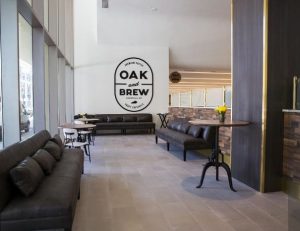By Marty Finley Reporter, Louisville Business First
The Kentucky International Convention Center reopened in downtown Louisville Monday morning — ending a two-year exile of the building while it underwent a $207 million renovation and expansion.
The work is expected to quickly pay off in the form of a 25 percent to 30 percent boost in local convention and trade show business.
“Downtown Louisville is open for convention business,” Louisville Tourism President and CEO Karen Williams said shortly before KICC General Manager Stacey Church cut the ribbon and a crowd of hundreds was serenaded by Louisville musical act Linkin’ Bridge.
The new rendition of KICC houses nearly 1 million square feet of space across three main floors and has booked 120 groups to date, including 84 conventions with an estimated economic impact of $246 million, according to Louisville Tourism officials. During its two-year closure, the west end of the building was demolished and rebuilt with large windows and skylights, providing a focus on glass, open space, modern technology and natural light.
Inside, the new KICC has a little more than 200,000 square feet of contiguous exhibit hall space, a 40,000-square-foot main ballroom, 52 meeting rooms, a 175-seat tiered conference theater and a new kitchen that can accommodate as many as 15,000 meals per day.


It also is home to Oak & Brew, a food and beverage destination that will offer coffee and grab-and-go food items for convention and trade show guests in the morning. The concept will then morph into a bourbon bar with an expansive bourbon list during the evenings. Oak & Brew is managed by KICC culinary partner Levy Restaurants, based in Chicago.
Monday’s ceremony drew a number of Louisville politicians, business and civic leaders, including real estate developer Bill Weyland, Omni Louisville Hotel General Manager Scott Stuckey and University of Louisville President Neeli Bendapudi.
Several of the ceremony’s featured speakers spoke about the challenge of renovating the building on a tight budget and tight timeframe, which forced state officials to haggle over the price and design early on to ensure it did not become cost-prohibitive.
For instance, expanding the convention center skyward with additional stories proved too expensive, so Lexington-based EOP Architects and the Chicago office of global architecture and engineering firm HOK came up with a cantilevered layout that extends the building above downtown streets, including Jefferson Street.
“There was no magic button for success,” said William Landrum III, secretary of the Kentucky Finance and Administration Cabinet. Landrum argued instead that it took old-fashioned hard work and expertise to juggle the project, which was led by Hunt Construction with more than 60 contractors and subcontractors.
Mayor Greg Fischer said KICC is a testament to Louisville’s progress but also a player in the city’s economic renaissance as it transitions into a city awash in bourbon tourism.
He praised the state for its active role in improving the convention center, saying officials showed grit and determination in keeping KICC on budget and on schedule.
“People talk,” Fischer said. “I don’t watch lips. I watch actions.”
New Kentucky Venues CEO David Beck said he wants to see KICC create jobs and become a good example of stewardship within state government.
“We want to be part of the economic engine in this community,” he said.

